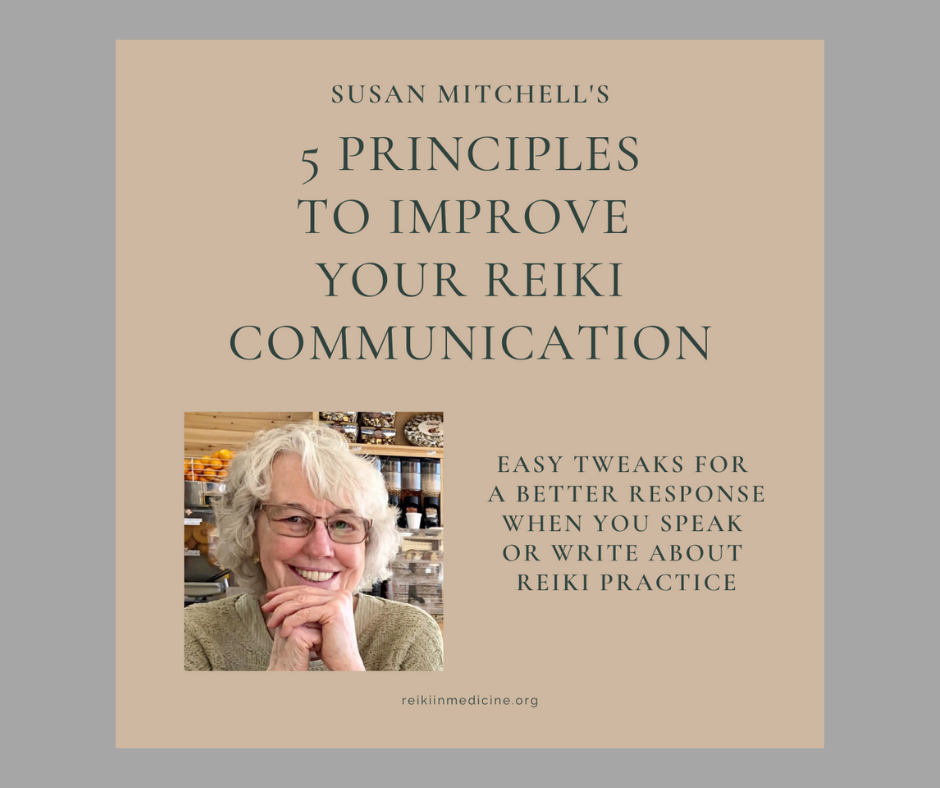We’re living in times of great uncertainty and people are reaching for clear information in a sea of conflicting perspectives. People who expect science to have answers it just doesn’t have are especially stressed and confused. The New York Times put it in perspective, quoting epidemiologist Michael Osterholm, PhD, MPH of the University of Minnesota as saying, “We still are really in the cave ages in terms of understanding how viruses emerge, how they spread, how they start and stop, why they do what they do.”
At times of uncertainty, it’s especially hard to stay steady. Given that anxiety compromises our immunity, steadiness is needed now more than ever. Reiki practice helps immeasurably, yet it can be challenging to convey that information to the mainstream public.
Besides the urgency for clear information brought by the pandemic, some states are moving towards licensing Reiki, which in some presentations can look very sketchy. The need for credible Reiki information has never been greater than it is now.
Reiki Master Susan Mitchell well understands the challenge of communicating Reiki and the need to do it well. Trained by Hawayo Takata, Susan became the first director of The Reiki Alliance and an editor of the Dutch Reiki Magazine International. Susan helped curate the Hawayo Takata archives now housed at the University of California, Santa Barbara. In 2019, Susan edited In Her Own Voice, A Tribute to Phyllis Lei Furumoto, 1948-2019, and this year, she’ll begin editing Hawayo Takata’s memoir. Susan is a founder of Reiki Unified, a nationwide effort to oppose regulation of Reiki practice in the United States.
When Susan spoke in my last Reiki & Medicine Intensive, the participants were so inspired that I asked her to share her presentation as an article, including her 5 Principles for Reiki Communication.
Improving my Reiki Communication
by Susan Mitchell
In 2008, I attended the Reiki & Medicine Intensive Pamela Miles gave in Seattle. Knowing she’s constantly updating her content, I recently attended another.
Pamela communicates Reiki in a unique way, bringing together Reiki practice, science, and spirituality. I find it intriguing and practical.
While I’m not practicing Reiki in health care, and don’t aspire to, I do a lot of speaking and writing about Reiki practice, and I’ve become very involved in the legislative threats to our freedom to practice Reiki as we choose. As a co-founder of the non-profit Reiki Unified, I’m looking for clear ways to communicate Reiki practice to politicians and legislators.
If I can credibly communicate Reiki practice in a medical setting, I’m confident I’ll have the skills to communicate with anyone, regardless of what they know or think about Reiki practice, regardless the misinformation they’ve been exposed to.
I’m acutely aware it’s not the responsibility of the person I’m speaking to, to understand me – it’s my responsibility to speak to them in a way they can understand and that interests them. Since the intensive, I’ve been integrating Pamela’s guidance on how best to do that.
Honing My Reiki Words
I learned Reiki in 1978. Perhaps like you, I’ve always thought of Reiki in terms of energy, and so that’s how I spoke. Sometimes when I spoke of Reiki energy, it landed well; other times, I’ve internally winced, seeing my listener’s eyes glaze over with disinterest. Now as the need for my Reiki communication to be effective is getting greater, I’ve realized how the Reiki-energy language has limited my audience.
When I talk about the way our physiology constantly influences, and is influenced by, our day-to-day experience, I find my Reiki communication becomes more grounded.
While I’m very aware of the mind, body, spirit connection, I had little knowledge of the actual processes that take place in the body. The Reiki & Medicine Intensive significantly increased my knowledge so I not only understand what happens in my body, but I can also identify the experience.
Pamela explained how every human experience elicits physiological responses that reverberate throughout the body, affecting not only the body, but also the mind and spirit. That cascade of simultaneous interactions can be helpful or harmful.
Extensive medical research on stress and stress-induced illness shows how prolonged physiologic interactions to stress lead to imbalance and illness.
When I speak from a physiologic perspective, I find people relate to the description of chronic stress, acknowledging their experiences of hopelessness, inadequate sleep, depression, or poor choices. They want relief.
The connectedness of body, mind and spirit no longer sounds airy-fairy when linked to someone’s physiologic response to Reiki practice; the biological element becomes clear. Not only do we feel better after Reiki practice, there can be measurable physiologic changes — improvements in heart rate, respiration, blood pressure, and heart rate variability.
 Changing My Reiki Communication
Changing My Reiki Communication
It’s a challenge for me to shift my Reiki communication style from talking about energy, which people either believe in or dismiss, to speaking about the responses to Reiki practice people really feel, differences they notice in their bodies and their minds, and how the details of their lives play out.
Integrating this perspective into my Reiki communication is requiring study and practice. I’m not there yet. And, I’m finding it’s worth my time. I put together 5 principles to improve my Reiki communication.
5 Principles for Improving my Reiki Communication
Needing ways to integrate the material in the intensive, I wrote five communication principles based on Pamela’s work.
- Avoid language that separates people from what I’m saying by expressing opinions or beliefs as if they were facts.
- Develop self-discipline: be aware of what I say and especially of what I don’t say. Communicate with respect, patience, and restraint. No persuading. Share information and let people make their own decisions.
- Connect with people’s needs: listening more deeply for the person’s spoken or unspoken question. Most often that question revolves around, “How can Reiki help me?” When I respond to that, they hear me and recognize the possibilities for themselves.
- No matter with whom I’m communicating — practitioners from this Reiki style or that, people who practice Reiki or don’t — emphasize what we share and focus on collaboration.
- Describe the benefits of Reiki practice as bringing balance, based on self-healing and grounded in science.
Sharing a Language
What if we developed a common language, instead of assuming people understand our Reiki dialect? This would enable more people to connect with Reiki practice and to us as practitioners. In turn, we would support more people to embrace their own self-care.
At one point in the intensive, I heard Pamela say, “Reiki as spiritual practice means that if we practice consistently, we get to carry the depths, subtlety, nuance and centeredness that daily self-practice brings. We get to carry that into environments where it may be lacking.”
How privileged we are to have opportunities to communicate that can bring Reiki practice into places where it’s not often found. This is a work in progress — and it is taking work — but I’m also seeing real progress in the improved response to my Reiki communication.
_____________
Please share this article widely. Regardless your Reiki lineage or practice style, offering more credible Reiki presentations to the mainstream public and health care is critical to protecting the future of our practice. Susan’s principles also empower Reiki practitioners to express themselves effectively as more states consider bills that would require licensing to practice Reiki. It’s important that we can convey what we do, how people benefit, and the lack of risk in clear, straightforward language, regardless our personal beliefs.
Learn more about Hawayo Takata in Reiki Changes.
See when the next Reiki & Medicine Intensive is scheduled here.
Join my list for reliable, helpful, credible Reiki information.


We act as a channel for Reiki energy to come through us. After that, the energy will go through the energy body. The energy body has its own intelligence and knows what to do. This is what we have to remember when we do Reiki healing.
Thank you for your comment, Stefan. I understand that’s how most people conceptualize Reiki.
However, the whole concept of Reiki energy is itself a mistranslation. It’s simply doesn’t represent Japanese cultural understanding, especially at Usui’s time. It’s an artifact of (albeit unintentional) American appropriation of a misunderstood practice.
It’s problematic that most Reiki practitioners think and present in terms of Reiki energy. Not only is that perspective not aligned with Usui’s practice, it also introduces a concept that is generally seen as counter-cultural in Euro-American cultures, which causes many people to think erroneously that Reiki practice is not relevant to them.
Reiki practitioners could avoid all of those communication obstacles by talking about Reiki practice and focusing on the measurable and immediately perceivable beneficial responses, rather than beliefs that the mainstream public find off-putting, such as “channeling.”
Make sense?
Yes, I describe Reiki as energy. I’ve also seen that look from people who do not understand. So, I begin to tell them how I’ve helped others. So, I basically I have backed away from “selling” it, because that’s what I have been doing. These articles have came to me at a very important time in my life as well as an important time when people could benefit immensely. People need this! I have been pondering how to communicate Reiki in a more “professional” way. The time is right.
A great reminder that we need to explain Reiki in terms that display benefits to the receiver and the giver, of course. Keep it simple, no claims, only what can happen to the physiology of the body.
Pamela and Susan thank you so much for this clear and concise article. It is wonderful to know that we can all learn from each other wherever we come from in our practice. I continue to experience Reiki like an unfolding flower, each day it offers new wisdom, beauty and challenge. Sometimes things shift and open in more profound ways and I gain a deep sense of peace. Other times I am just brought to an awareness and letting go of tension in my body. Every practice is as valuable as the next. I am grateful Pamela for your work encouraging and supporting us all in daily self-practice and to Susan for your openness and honesty in talking about reflecting on and changing the way you communicate Reiki and so helping us all along with that.
What a super article, Pamela – I hold your teachings from the Reiki in Medicine Intensive close to my heart and it was a treat to have them reflected in Susan’s insightful and inspiring words. Many thanks to you both for this lovely and transferable gift. The more clarity we have when we talk about Reiki, the more meaningfully we’ll be able to communicate with everyone – and then Reiki wins!